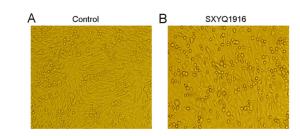-

-

-

-
Collection site Breeding places Total Sheep pen Chicken pen Cattle pen 1 554 183 310 1047 2 381 107 / 488 Total 935 290 310 1535 "/" represents the missing cattle pen.
"1" indicates the first sampling village (east longitude 113°37′12″, north latitude 37°46′48″). There were more than 100 chickens in the chicken pen, 170 sheep in the sheep pen, and 18 cattle in the cattle pen. The distance between the three pens was less than 1000 m. "2" indicates the second sampling village (east longitude 113°38′24″, north latitude 37°45′). There were 70 sheep in the sheep pen and 10 chickens in the chicken pen. Sheep and chicken pens were in the courtyard of the residents, which had two dogs in the house. The two pens were approximately 2 km apart, and the two villages were about 4 km apart.Table 1. Collection sites of sandfly specimens in Yangquan County, Shanxi Province in 2019.
-
Strain number Collection site Breeding places Number of Phlebotomus chinensiss CPE/ Gene amplification BHK-21 cell WUXV C6/36 cell WUXV L M S M S SXYQ1931 1 Sheep pen 60 + / MW192757 MW192753 – – – SXYQ1916 2 Sheep pen 49 + / MW192754 MW192750 – – – SXYQ1930 2 Sheep pen 74 + / MW192756 MW192752 – – – SXYQ1927-2 2 Chicken pen 54 + MW368897 MW192755 MW192751 – – – Numbers indicate the collection location. Numbers 1 and 2 indicate the first and second sampling villages, respectively; " + " means that the experimental result is positive; "–" means that the experimental result is negative; "/" means that the experiment was not performed. Table 2. Isolation of Wuxiang virus in Yangquan County, Shanxi Province in 2019.
-
Breeding places Number of sandflies Pool Infection rate of pools (%) MIR (/1000) Chicken pen 290 5 20.00 (1/5) 3.45 (1/290) Sheep pen 935 14 21.43 (3/14) 3.21 (3/935) Cattle pen 310 4 0.00 (0/4) 0.00 (0/310) Table 3. Infection rate of Sandfly-borne virus.
-
Virus strains M segment S segment GP NS N nt (%) aa (%) nt (%) aa (%) nt (%) aa (%) SXYQ1916 4089 1362 783 260 741 246 SXWX1813-2 4089(96.7) 1362(97.6) 783(97.1) 260(97.7) 741(98.0) 246(99.6) TORV(213/Turkey/2012) 4080(72.0) 1359(75.1) 783(75.4) 260(85.1) 741(82.2) 246(96.4) TORV(292/Turkey/2012) 4081(72.0) 1359(75.1) 783(75.2) 260(85.1) 741(81.9) 246(96.0) CFUV(Pa Ar 814/Greece/1981) 4080(71.3) 1359(75.7) 783(74.5) 260(84.3) 741(81.9) 246(96.4) SFSV(Ethiopia-2011/Ethiopia / 2011) 4026(62.6) 1341(57.1) / / 741(74.4) 246(84.2) SFSV(Sabin/Italy/1943) / / 783(53.3) 260(63.6) 741(75.3) 246(83.8) DASHV(131/Iran/2011) 4029(65.2) 1342(58.6) 786(58.1) 261(61.7) 741(76.5) 246(85.0) RVFV(ZH-548/Egypt/1977) 3594(36.0) 1197(39.9) 798(15.5) 265(24.1) 738(55.4) 245(52.8) "/" indicates that the sequence was not available in the GenBank database. Table 4. Homology analysis of the newly isolated virus (SXYQ 1916) and other Phleboviruses.
-
Number Gender Age Livestock raised Neutrlization test (Serum dilution) WUXV gene amplification Chicken Sheep Dog WX14 Female 66 10 – 1 + (1:10) – WX28 Male 68 + (1:20) – WX34 Male 61 – – 1 + (1:20) – WX44 Male 59 – – 1 + (1:10) – Table 5 shows the background information of healthy people and chickens with neutralizing antibody positive in serum specimens. The blood donors of WX14 and WX28 came from the same family, which raised 10 chickens and 1 dog. Other positive individual families raised only one dog but not sheep, chickens and other livestock and poultry. "–" means that the experimental result is negative. Table 5. Detection of neutralizing antibody against WUXV.
Figure 3 个
Table 5 个